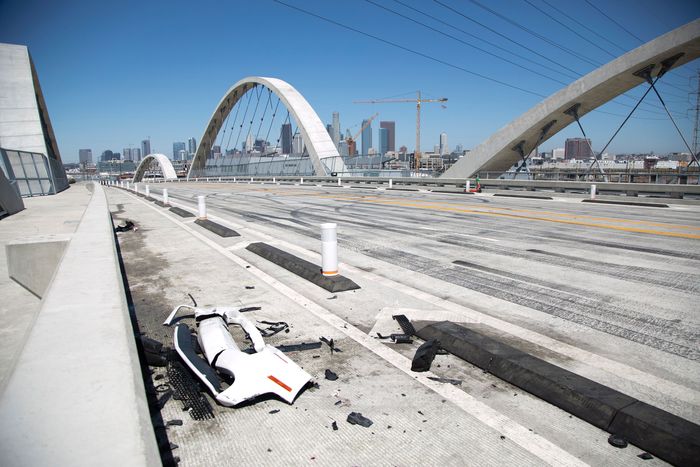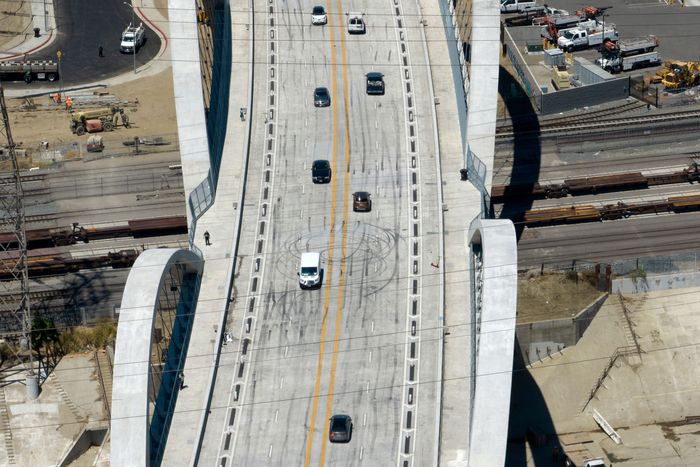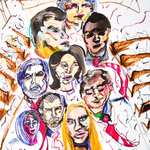
The skid marks from Monday night’s crash stretched across four lanes of traffic. Two cars had hit each other, ricocheted in opposite directions, and come to rest against concrete barriers on either side, slipping between the plastic posts meant to demarcate the bike lanes. The next morning, the bumper from one of the cars was still there — commuters on bikes and scooters dodged it. The brand-new 6th Street Bridge over the L.A. River, connecting Boyle Heights to the Arts District, was supposed to be a symbol of the city’s move away from a car-centric past and toward a future of more pedestrians and cyclists. It had been open for about a week before drivers plowed into not just one bike lane but both of them simultaneously. Somehow, no one was hurt.
“This is the first bridge built in the Instagram era in L.A., and as we’ve seen, people will do anything in the pursuit of virality,” City Councilmember Kevin de León told the Los Angeles Times, calling the collision a matter of reckless stunt-driving. (De Léon was the first person to cross the bridge, driving a low-rider, in a video he later posted to Instagram.) But the bridge, which is essentially designed to be a freeway overpass, was not built to forestall such a collision either: There are four lanes of fast-moving traffic separated from its two bike lanes by plastic tubes mounted on rubber slabs screwed into the roadway more than a vehicle-width apart.
The old 6th Street Bridge — a viaduct, technically, over multiple freeways and railways in addition to the river itself — first opened in 1932 and had to be replaced due to structural issues known as “concrete cancer.” Its replacement, announced in 2012, presented an opportunity, and the early renderings by architect Michael Maltzan showed promise: a second, well-shaded promenade just below the main span dedicated to pedestrians and cyclists; Escher-like staircases over the arches; acres of park space beneath. But that premise was significantly whittled down over the past decade, giving way to cars and more cars. (The park, still in the mix, will open next year.) At either end, where the $588 million bridge touches back down to the grid, the walkways peter out into a narrow sidewalk with a single diagonal curb ramp and the barely protected bike lanes evaporate into sharrows, forcing cyclists to share vehicular lanes without any plastic between them at all. It serves anyone who wants to walk or bike to work pretty poorly: Boyle Heights residents headed downtown must cross three freeways on unimproved overpasses just to get to the new part.
Since the beginning, reporters and advocates have raised flags; Streetsblog L.A. spent the better part of a decade questioning the design. (The project descriptions assured that the lanes were “protected,” yet they never appeared to be in renderings.) After the bridge opened, LAist reporter Ryan Fonseca tried to get answers about its safety from L.A.’s Department of Transportation, which said the decisions were made by the state transportation agency Caltrans, which deferred to the city’s Bureau of Engineering, which referred him to the statement made by LADOT.
The bridge is still actually not finished; workers were closing lanes for construction this week, and a few barriers consist of temporary chain-link fences, some impaled with solar garden lights that look like they were purchased from Home Depot. Which signals that there may be a window for an intervention. What might the city do? Install a median to prevent street racing? Dedicate one lane in each direction to buses only? Place K-rail construction barriers — to be replaced by a more permanent solution — to protect the bike lanes?
These are relatively easy fixes, and the city almost certainly won’t make them.
At the ribbon-cutting, L.A. mayor Eric Garcetti reminded the crowd that the bridge was envisioned to be a gathering space and suggested, rather surprisingly, that it might be closed to traffic frequently to host major civic events. In a way, despite the limited access and unforgiving environment, this part has already come true. As the heat dissipates every evening, hundreds of people flock to the bridge at sunset — the LED-lit arches geotagged with selfies of the downtown skyline against a sensational pastel ombré. Thousands of people showed up for the opening weekend programmed with both car-free activities and a low-rider caravan, the types of gatherings that might be regularly scheduled.
The night of the crash, what was so remarkable about the videos posted to Instagram was how cinematic the whole thing looked: like a car ad that quickly devolved into the latest installment of the Fast & Furious franchise. According to the city’s film-permit office, productions can start shooting on the bridge on September 1, when officials can close it to the public — not just to traffic, completely closed to everyone — as professionals speed and do donuts for movies and commercials. At least those crashes will be controlled.





